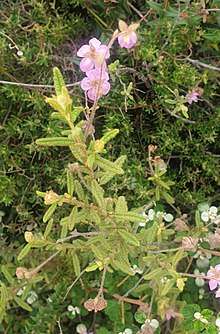Thomasia petalocalyx
Thomasia petalocalyx, commonly known as paper flower, is endemic to southern and western parts of Australia. The flowers are bell-like, a delicate pink with 5 papery segments and hang low to the ground.[2]
| Thomasia petalocalyx | |
|---|---|
 | |
| Scientific classification | |
| Kingdom: | Plantae |
| Clade: | Tracheophytes |
| Clade: | Angiosperms |
| Clade: | Eudicots |
| Clade: | Rosids |
| Order: | Malvales |
| Family: | Malvaceae |
| Genus: | Thomasia |
| Species: | T. petalocalyx |
| Binomial name | |
| Thomasia petalocalyx | |
Description
Thomasia petalocalyx is a short shrub, 0.25 - 1.2m high that grows in coastal and drier, sandy regions in southern Australia. Leaves are ovate to lanceolate, 10-40mm long and 4-11mm wide. Stipules are leaf-like, 8-12mm long and 4-8mm wide. Flowers have a single whorl of 5 . Calyx has 5 segments, 7-8mm long and 3.5-4.5mm wide with have a papery texture, hence the specific common name. Petals are red and reduced in size, less than 1mm long. Anthers are a red-brown colour approximately 2mm long. Flowers from September to March.
Distribution and habitat
The Paper Flower is found in coastal and drier heathy areas throughout Southern Australia from Albany in Western Australia to Port Phillip Bay in Victoria, with an isolated population in Wilson Promontory.
Taxonomy
Thomasia pentalocalyx was first described by Ferdinand von Mueller in Definitions of rare or hitherto undescribed Australian plants [3]
References
- von Mueller, Ferdinand. "Thomasia petalocalyx". Australian Plant Census. Retrieved 17 February 2020.
- von Mueller, Ferdinand. "Thomasia petalocalyx". FloraBase. Retrieved 17 February 2020.
- von Mueller, Ferdinand. "Definitions of rare or hitherto undescribed Australian plants". Australian Plant Name Index. Retrieved 17 February 2020.